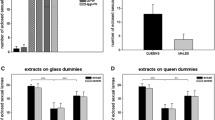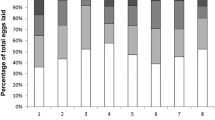Abstract
The ability of workers to produce male individuals is reported here for the first time in a species of the formicine ant genus Prolasius. We show that Prolasius advenus workers possess ovaries and demonstrate that they are able to produce adult males in queenless colonies. We also experimentally tested the influence of queen volatiles on the level of worker reproduction. Workers produced fewer eggs in treatments where they could perceive odors from queens. Some volatile compounds emitted by queens may thus have a signaling or inhibitory effect on worker reproduction. This effect of queen presence did not entirely stop worker reproduction, however, as adult males still emerged under these conditions. Worker-produced males were absent only in treatments with the physical presence of queens. Dissections of workers collected from queenright nests in the field revealed signs of egg-laying activity in more than half of individuals. Together, these results suggest that in nature P. advenus workers produce males at least in orphaned colonies or in situations where the physical presence of queens is limited.




Similar content being viewed by others
References
Bourke A.F.G.1988. Worker reproduction in the higher eusocial Hymenoptera. Q. Rev. Biol. 63: 291–311
Brunner E. and Heinze J. 2009.Worker dominance and policing in the ant Temnothorax unifasciatus. Insect. Soc. 56: 397–404
Brunner E., Kroiss J., Trindl A. and Heinze J. 2011. Queen pheromones in Temnothorax ants: control or honest signal? BMC Evol. Biol. 11: 55
Coston D.J., Gill R.J. and Hammond R.L. 2011. No evidence of volatile chemicals regulating reproduction in a multiple queen ant. Naturwissenschaften 98: 625–629
Dietemann V., Hölldobler B. and Peeters C. 2002.Caste specialization and differentiation in reproductive potential in the phylogenetically primitive ant Myrmecia gulosa. Insect. Soc. 49: 289–298
Don W. 2007. Ants of New Zealand. Otago University Press, Dunedin, New Zealand.
Endler A., Liebig J., Schmitt T., Parker J.E., Jones G.R., Schreier P. and Hölldobler B. 2004. Surface hydrocarbons of queen eggs regulate worker reproduction in a social insect. Proc. Natl Acad. Sci. USA 101: 2945–2950
Faul F., Erdfelder E., Lang A.-G. and Buchner A. 2007. G*Power 3: A flexible statistical power analysis program for the social, behavioral, and biomedical sciences. Behav. Res. Meth. 39: 175–191
Gobin B., Billen J. and Peeters C. 1999. Policing behaviour towards virgin egg layers in a polygynous ponerine ant. Anim. Behav. 58: 1117–1122
Grangier J. and Lester PJ. 2011. A novel interference behaviour: invasive wasps remove ants from resources and drop them from a height. Biol. Lett. 7: 664–667
Hammond R.L. and Keller L. 2004.Conflict over male parentage in social insects. PLOS Biology 2: 1472–1482
Heinze J. and d’Ettorre P. 2009. Honest and dishonest communication in social Hymenoptera. J. Exp. Biol. 212: 1775–1779
Hölldobler B. and Wilson E.O. 1990. The Ants. The Belknap Press of Harvard University Press, Cambridge, Massachusetts.
Holman L., Jørgensen C.G., Nielsen J. and d’Ettorre P. 2010. Identification of an ant queen pheromone regulating worker sterility. Proc. R. Soc. Lond. B 277: 3793–3800
Keller L. and Nonacs P. 1993. The role of queen pheromones in social insects: queen control or queen signal? Anim. Behav. 45: 787–794
Monnin T. 2006. Chemical recognition of reproductive status in social insects. Ann. Zool. Fennici 43: 515–530
Ohtsuki H. and Tsuji K. 2009. Adaptive reproduction schedule as a cause of worker policing in social Hymenoptera: a dynamic game analysis. Am. Nat. 173: 747–758
Peeters C., Liebig J. and Hölldobler B. 2000. Sexual reproduction by both queens and workers in the ponerine ant Harpegnathos saltator. Insect. Soc. 47: 325–332
Smith A.A., Hölldobler B. and Liebig J. 2011.Reclaiming the crown: queen to worker conflict over reproduction in Aphaenogaster cockerelli. Naturwissenschaften 3: 237–240
Smith C.E. 1969. A morphological and behavioural study of the ants Amblyopone saundersi Forel and Prolasius advena Fr. Smith (Hymenoptera: Formicidae). Unpublished BSc(Hons) thesis, University of Otago, Dunedin
Shattuck S.O. 1999. Australian Ants: Their Biology and Identification. Monographs in Invertebrate Taxonomy. Volume 3
Tsuji K., Egashira K. and Hölldobler B. 1999. Regulation of worker reproduction by direct physical contact in the ant Diacamma sp. from Japan. Anim. Behav. 58: 337–343
Van Zweden J.S. 2010. The evolution of honest queen pheromones in insect societies. Commun. Integr. Biol. 3: 50–52
Wenseleers T. and Ratnieks F.L.W. 2006. Comparative analysis of worker reproduction and policing in eusocial Hymenoptera supports relatedness theory. Am. Nat. 168: 163–179
Acknowledgments
We are grateful to Evan Brenton-Rule for lab assistance, to Allan Burne, Monica Gruber and Alexandra Sébastien for useful discussions, to two anonymous reviewers for useful comments on the manuscript, and to the Department of Conservation of New Zealand for allowing us to work in the Nelson Lakes National Park. This work was supported by a RSNZ Marsden fund grant.
Author information
Authors and Affiliations
Corresponding author
Rights and permissions
About this article
Cite this article
Grangier, J., Avril, A. & Lester, P.J. Male production by workers in the polygynous ant Prolasius advenus . Insect. Soc. 60, 303–308 (2013). https://doi.org/10.1007/s00040-013-0294-6
Received:
Revised:
Accepted:
Published:
Issue Date:
DOI: https://doi.org/10.1007/s00040-013-0294-6




